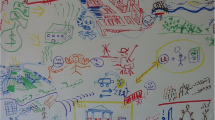Abstract
Twenty-seven Grade 5/6 students working in triads considered a supplied data set. They were asked to hypothesise about associations in the data and to represent these. Each student was classified according to the level of interpreting the information, the level of representing the chosen data, and the type of collaboration observed in the group. Levels of interpretation and representation skills were related and there was some indication of a possible association with the type of collaboration. There was no association of type of collaboration and students’ views on group work. Implications for future research and the classroom are considered.
Similar content being viewed by others
References
Artzt, A. F., & Armour-Thomas, E. (1992). Development of a cognitive-metacognitive framework for protocol analysis of mathematical problem solving in small groups.Cognition and Instruction, 9, 137–175.
Australian Education Council. (1991).A national statement on mathematics for Australian schools. Melbourne:Curriculum Corporation.
Australian Education Council. (1994).Mathematics: A curriculum profile for Australian schools. Melbourne:Curriculum Corporation.
Biggs, J. B., & Collis, K. F. (1982).Evaluating the quality of learning: The SOLO taxonomy. New York, NY:Academic Press.
Biggs, J. B., & Collis, K. F. (1991). Multimodal learning and the quality of intelligent behaviour. In H. A. H. Rowe (Ed.),Intelligence: Reconceptualisation and measurement (pp. 57–76). Hillsdale, NJ:Lawrence Erlbaum.
Chick, H. L., & Watson, J. M. (1998). Showing and telling: Primary students’ outcomes in data representation and interpretation. In C. Kanes, M. Goos, & E. Warren (Eds.),Teaching mathematics in new times (Proceedings of the 17th annual conference of the Mathematics Education Research Group of Australasia, pp. 153–160). Brisbane:MERGA.
Davidson, N. (1985). Small-group learning and teaching in mathematics: A selective review of the research. In R. Slavin, S. Sharan, S. Kagan, R. Hertz-Lazarowitz, C. Webb, & R. Schmuck (Eds.),Learning to cooperate, cooperating to learn (pp. 211–230). New York, NY:Plenum Press.
Good, T. L., Mulryan, C., & McCaslin, M. (1992). Grouping for instruction in mathematics: A call for programmatic research on small-group processes. In D. A. Grouws (Ed.),Handbook of research on mathematics teaching and learning (pp. 165–196). New York:Macmillan.
Gooding, A. (1994). Recognition of effective group discussion. In G. Bell, B. Wright, N. Leeson, & J. Geake (Eds.),Challenges in mathematics education: Constraints on construction (Proceedings of the 17th annual conference of the Mathematics Education Research Group of Australasia, pp. 295–305). Lismore, NSW:MERGA.
Johnson, D. W., & Johnson, R. T. (1989). Cooperative learning in mathematics education. In P. R. Trafton (Ed.),New directions for elementary school mathematics (pp. 234–245). Reston, VA:National Council of Teachers of Mathematics.
Lajoie, S. P., Jacobs, V. R., & Lavigne, N. C. (1995). Empowering students in the use of statistics.Journal of Mathematical Behavior, 14, 401–425.
Lajoie, S. P., & Lavigne, N. C. (1994). How does group composition and gender influence the learning of statistics? Paper presented at the annual conference of the American Education Research Association in New Orleans, LA..
Lehrer, R., & Romberg, T. (1996). Exploring children’s data modelling.Cognition and Instruction, 14, 69–108.
Lidster, S. T., Chick, H. L., & Watson, J. M. (1997). Developing cognition in interpreting data. In N. Scott & H. Hollingsworth (Eds.)Mathematics: Creating the future (Proceedings of the 16th biennial conference of the Australian Association of Mathematics Teachers, pp. 202–209). Adelaide:AAMT.
Maxwell, J. A. (1996).Qualitative research design: An interactive approach. Thousand Oaks, CA:Sage.
Miles, M. B., & Huberman, A. M. (1994).Qualitative data analysis: An expanded sourcebook (2nd ed.). Thousand Oaks, CA:Sage.
Ministry of Education. (1992).Mathematics in the New Zealand curriculum. Wellington, NZ:Author.
National Council of Teachers of Mathematics (2000).Principles and standards for school mathematics. Reston, VA:Author.
Phelps, E., & Damon, W. (1989). Problem solving with equals: Peer collaboration as a context for learning mathematics and spatial concepts.Journal of Educational Psychology, 81, 639–646.
Ross, J. A., & Cousins, J. B. (1995a). Giving and receiving explanations in cooperative learning groups.Alberta Journal of Educational Research, 41, 103–121.
Ross, J. A., & Cousins, J. B. (1995b). Impact of explanation seeking on student achievement and attitudes.Journal of Educational Research, 89, 109–117.
Russell, S. J., & Corwin, R. B. (1989).Statistics: The shape of the data. Grades 4–6. Palo Alto, CA:Dale Seymour.
Slavin, R. E. (1989–1990). Research on cooperative learning: Consensus and controversy.Educational Leadership, 47(4), 52–54.
Slavin, R. E. (1992). When and why does cooperative learning increase achievement? Theoretical and empirical perspectives. In R. Hertz-Lazarowitz & N. Miller (Eds.),Interaction in cooperative groups: The theoretical anatomy of group learning (pp. 145–173). Cambridge, UK:Cambridge University Press.
Stacey, K. (1992). Mathematical problem solving in groups: Are two heads better than one?Journal of Mathematical Behavior, 11, 261–275.
Watson, J. M., & Callingham, R. A. (1997). Data cards: An introduction to higher order processes in data handling.Teaching Statistics, 19,12–16.
Watson, J. M., & Chick, H. L. (in press). Factors influencing the outcomes of collaborative mathematical problem solving–An introduction.Mathematical Thinking and Learning.
Watson, J. M., Collis, K. F., Callingham, R. A., & Moritz, J. B. (1995). A model for assessing higher order thinking in statistics.Educational Research and Evaluation, 1, 247–275.
Webb, N. M. (1991). Task-related verbal interaction and mathematics learning in small groups.Journal for Research in Mathematics Education, 22, 366–389.
Author information
Authors and Affiliations
Rights and permissions
About this article
Cite this article
Chick, H., Watson, J. Data representation and interpretation by primary school students working in groups. Math Ed Res J 13, 91–111 (2001). https://doi.org/10.1007/BF03217101
Issue Date:
DOI: https://doi.org/10.1007/BF03217101




